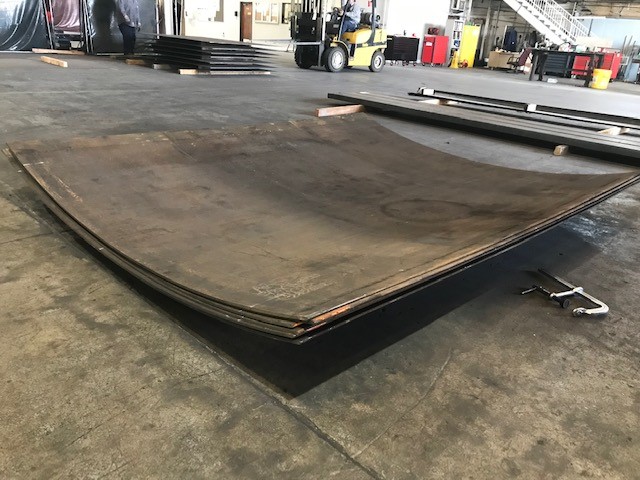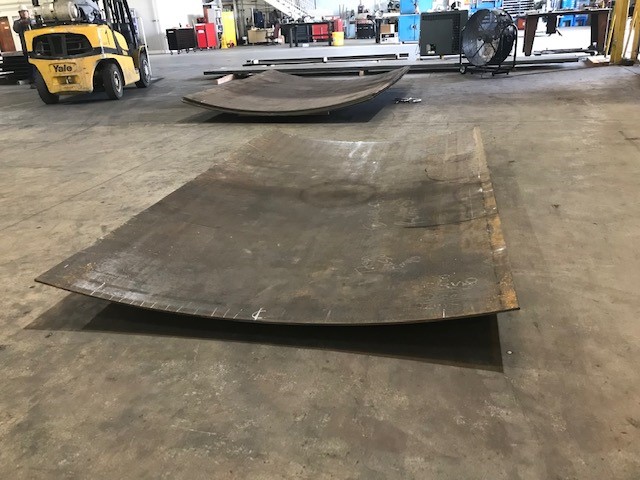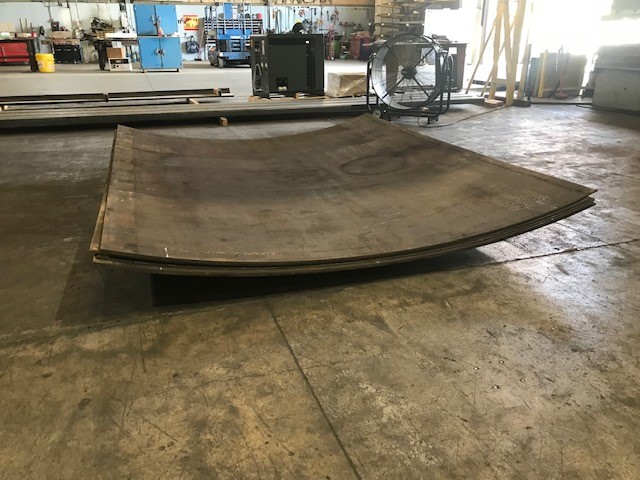
AR500 steel is so hard and impact-resistant that manufacturers use it to make armored cars, underground mining equipment, bulldozers, and excavators. It’s the very high carbon content that makes AR500 so much stronger and more rigid than most other steel plates.
In fact, AR500 is so tough that it will crack the rolling machine if not properly handled! Nevertheless, AR500 steel can be machined and formed if you follow the right process—you can see the evidence below from our recent AR500 roll forming at Kloeckner Metals Tulare!

Dating as far back as 600 BCE, roll forming is a process in which a machine bends and forms metal sheets into predetermined shapes. The roll forming machine has a huge array of rollers, each of which bends the steel slightly until the desired shape is achieved. Modern rolling machines rely on computer-aided design and programmable logic controllers to create precisely shaped metal. It’s a fast, effective, and affordable method of shaping steel.
Kloeckner Metals is a full-line steel supplier and service center. Download our structural plate spec sheet to learn what Kloeckner Metals routinely stocks.
Once correctly shaped, metal fabricators cut the AR500 plate to length and then weld it together. Welders can opt for one of several types of welding to join the AR500 sheet, including laser, gas tungsten arc welding (GTAW), gas metal arc welding (GMAW), flux-cored arc welding (FCAW), or submerged arc welding (SAW).
Roll formed steel is most often associated with mining since its abrasion-resistant qualities make it perfect for underground environments. It is also used to create products in the carpentry, construction, transportation, storage, and power distribution industries.
Roll forming is a type of metalworking that shapes a piece of metal by passing it through rollers. This process can be used to create objects with a long, continuous seam, such as pipes or tubes.
Regular forming, on the other hand, is a process that shapes metal by deforming it with tools like hammers or presses.
AR (abrasion-resistant) steel sheet is a high-carbon alloy steel specifically designed to resist wear and abrasion. The high carbon content gives the steel its hardness, while the chromium and other alloying elements give it its resistance to wear and abrasion.
The combination of these properties make it an ideal material for a variety of applications, including truck beds, liners, chutes, bucket lips, excavator buckets, crushers, conveyor belts, and many more.
An abrasion-resistant steel created through heat treatment, AR500 is lighter, harder, and lasts about three times as long as most other carbon alloy steels. It features a tensile strength of 225 ksi, yield strength of 200 ksi, and an elongation property of 12 percent. Chemically, AR500 steel includes manganese, phosphorus, sulfur, silicon, chromium, nickel, boron, and molybdenum.
Due to the steel’s extreme hardness, AR500 plates are very difficult to form. It is commonly used in applications where high demands are placed on the material– like bulletproof shields!
Can you roll form AR sheets? Yes! But it takes a special metal supplier with experience in fabrication services.
The steel’s rigidity and high abrasion resistance actually make it an ideal candidate for roll forming and AR500 can be cold rolled if you keep the bend axis transverse to the rolling direction. In order not to track, AR steel fibers need to be bent on a large surface. While a larger surface area can increase spring back to as high as 15-25 percent, a smaller area is much more likely to result in cracking.
AR500 plates can also be welded using low-hydrogen-producing electrodes.

While rolling equipment needs a lot of power to achieve deformation in abrasion resistant steel, it also needs control and precision. Not all roll forming machines are created equal to the task of abrasion resistant steel. As a result, it is important to choose a machine that is designed specifically for this material. While some types of roll forming can be performed by hand, most industrial processes require special equipment.
A roll forming machine consists of four basic components:
Modern roll forming machines feature computer aided design technology (CAD). CAD helps promote maximum efficiency by catching imperfections in the product and employing logic controllers that ensure accuracy.
We stock steel plates nationwide—with a special emphasis on abrasion resistant steel—at Kloeckner Metals Apache Junction, Chicago, Louisville, and York. To roll form AR steel, we use a process called cold rolling, which is when the steel is passed through rollers at room temperature. This helps to increase the steel’s strength and hardness.
We then anneal the steel, which is a process of heating and cooling it to relieve stress and make it more ductile. Finally, we temper the steel, which is another process of heating and cooling that gives the steel its final properties.
Shimming is the process of adding or removing material from a joint to make it level during welding.
When two pieces of metal are joined together, there is often an unevenness where they meet. This can be due to the manufacturing process, warping, or other factors. Shimming ensures that the joint is level, which makes for a stronger connection.
With AR500 steel, rolling should be the first choice for shaping. It’s faster than other options, and when we tested the roll to see if it would handle the job, it did. We also use special shimming techniques that help keep the joints level.
At Kloeckner, we used this technique to supply one customer with 40 rolled cylinders, each 60” in diameter. They will weld the cylinders together to create 30′ pipes.

If you’d like to speak to qualified experts who care about your AR steel project, contact us now. When it comes to steel, Kloeckner Metals combines a national footprint with the latest fabrication and processing technologies and most innovative customer service solutions.

Steel base plates are fundamental elements employed in various manufacturing...
Metal fabrication is a critical process that transforms raw metal...
The solar industry has undergone a significant transformation by incorporating...

X
The Kloeckner Metals website uses modern technologies. Unfortunately, your browser doesn't support those technologies.
Download the latest version of one of these browsers to experience the site: